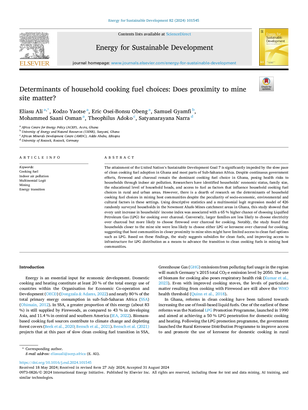Determinants of Household Cooking Fuel Choices: Does Proximity to Mine Site Matter?

The attainment of the United Nation's Sustainable Development Goal 7 is significantly impeded by the slow pace of clean cooking fuel adoption in Ghana and most parts of Sub-Saharan Africa. Despite continuous government efforts, firewood and charcoal remain the dominant cooking fuel choice in Ghana, posing health risks to households through indoor air pollution. Researchers have identified households' economic status, family size, the educational level of household heads, and access to fuel as factors that influence household cooking fuel choices in rural and urban areas. However, there is a dearth of research on the determinants of household cooking fuel choices in mining host communities despite the peculiarity of socio-economic, environmental and cultural factors in these settings. Using descriptive statistics and a multinomial logit regression model of 426 randomly surveyed households in the Newmont Ahafo Mines catchment areas in Ghana, this study showed that every unit increase in households' income index was associated with a 65 % higher chance of choosing Liquified Petroleum Gas (LPG) for cooking over charcoal. Conversely, larger families are less likely to choose electricity over charcoal but more likely to choose firewood over charcoal for cooking. Notably, the study found that households closer to the mine site were less likely to choose either LPG or kerosene over charcoal for cooking, suggesting that host communities in closer proximity to mine sites might have limited access to clean fuel options such as LPG. Based on these findings, the study suggests subsidies for clean fuels, and improving access to infrastructure for LPG distribution as a means to advance the transition to clean cooking fuels in mining host communities.
